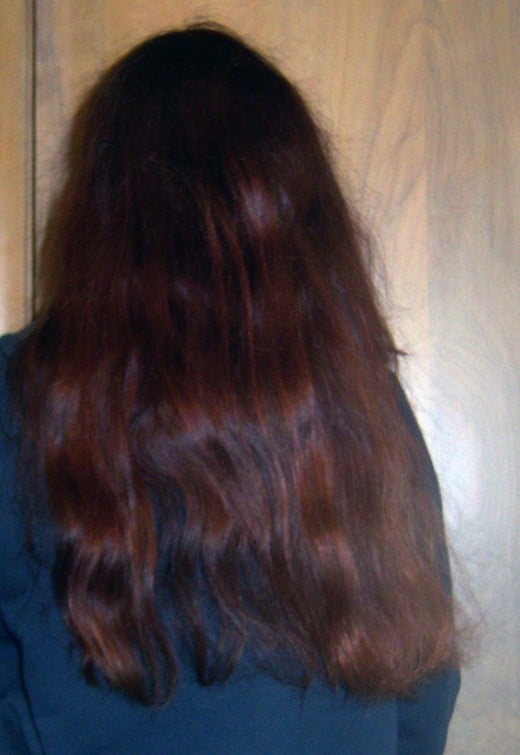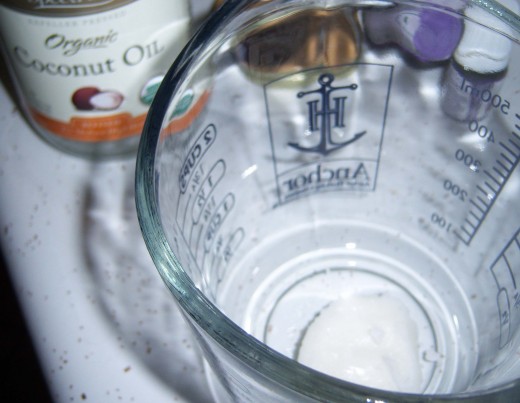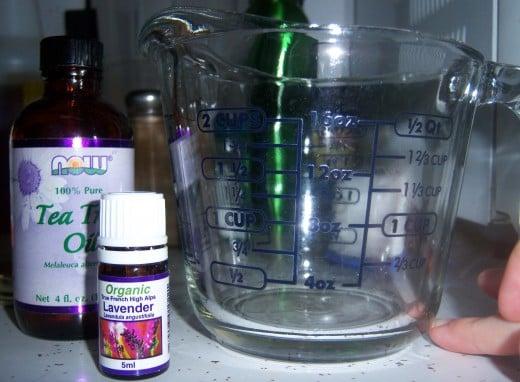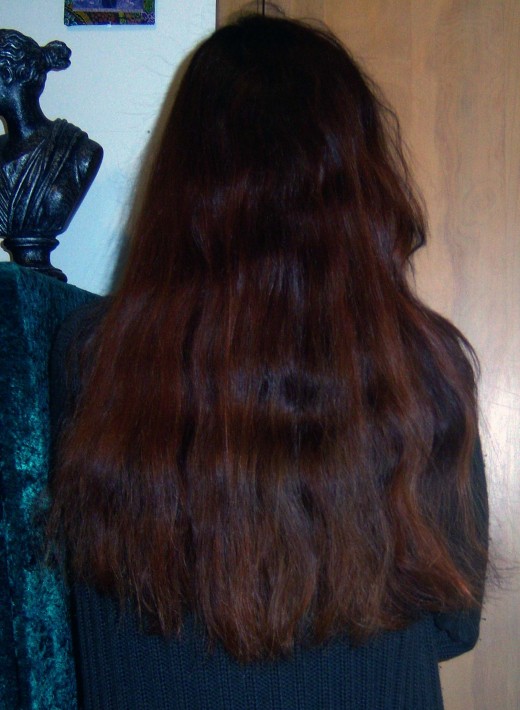DIY Hair Moisture With Essential Oils

Winter is one of the hardest times on your hair, especially if you happen to live in a cold climate. The air is naturally dryer outside and the air inside is dried even more, thanks to heating systems.
Those of us with naturally curly hair are already prone to damage associated with drying. However, a number of years ago, I stumbled upon a few wonderful oils that combine brilliantly for a regular oil treatment at home.
Ingredients and Supplies For Dry Hair Treatment
Before you can get started, you’ll need a few things.
- Glass measuring cup, or some sort of container with a spout
- Coconut oil (one to two tablespoons)
- Lavender oil (four to five drops)
- Tea tree oil (four to five drops)
- Plastic wrap
- Optional towel
When choosing a container, it's best to go for glass instead of plastic, because glass isn't as porous as plastic is. There is also some concern that the chemicals in plastic may leach into whatever is in the container if heated up.

Tips!
- Never ingest tea tree oil. Even a small amount can be deadly.
- When shopping for essential oils, always look for the the species and genus name on the bottle. Artificial oils can damage your skin, and won't have the same effect as natural essential oils will.
- This is a great idea for a sleep over, or simply mutual pampering session. It might be easier to do this for someone else, and have them return the favor, than doing it alone.
- Most essential oils must be diluted with a carrier oil, because they're so strong. Tea tree and lavender are two of the only oils that can be put directly onto the skin.
How To Moisturize Your Hair
Before you get started, brush your hair thoroughly. You can do this with un-brushed hair, but it’s just easier when you don’t need to deal with snarls.
You’ll also want to either wear something you don’t mind staining by accident, or drape an old towel around your shoulders. Oil is next to impossible to get out of fabric.
Mixing The Oil
Since coconut oil is a solid in normal room temperature, you’ll need to heat it up. I’ve heard the best way to do this is to put it in a glass bowl and set it in hot water, but I’ve also seen people use the microwave or a hair dryer.
Once the coconut oil is melted, I then put in the lavender and tea tree oil, and then mix them thoroughly.

Applying Homemade Moisturizer To Hair
I always start at my scalp and work my way down. To do this, I part my hair, let a little oil drip directly onto my skin, and then massage it into my scalp. I start at the front, and work my way back, until my whole scalp is covered. Once my scalp is covered, I work my way down the length of my hair, concentrating on the tips when I get there.
As you apply the oil, make sure to massage it gently into your scalp. That way, you’ll be getting the follicles, dry skin and cleaning any flakes from the surface. It also helps increase blood flow, and feels wonderful.
It’s important to coat your hair thoroughly, especially if you have a lot of damage to treat. That said, feel free to modify the recipe above if you need more or less.
For a little reference, my hair is currently 21 and a half inches long from scalp to tip, and surprisingly healthy considering it’s January in Minnesota. The above recipe saturates the full length moderately. If my hair was dryer, I would have needed more.
Once it’s in, wrap your hair in either a damp towel or plastic wrap, and let it set for at least an hour to two hours. You can keep it in your hair overnight if you have a bathing cap or you don’t mind getting oil stains on your pillow. If you have a day off, putting the oil in your hair in the morning and showering in the evening works well, too.
Wash it out with a mild shampoo or hair cleanser of your choice.
I repeat this process at least once or twice a month from January through March, due to the dry air in this area. However, you can repeat this treatment on a weekly basis if your hair is prone to over-drying, or you regularly blow dry it.
Another Great Method of Applying Coconut Oil to Hair
High Quality Coconut Oil
Why Do These Oils Help Treat Hair?
Part of why these are my favorite oils for this purpose is because they’re so easy to find. They’re also very gentle on your skin, in addition to their unique qualities.
Coconut Oil
This oil in particular has been used for centuries on hair. It reduces dandruff and can replace some of the natural moisturizing agents washed away by shampoos. There have apparently been studies which demonstrate its ability to get into the hair shaft to help prevent further loss of protein. You’ll be able to find it at any grocery store, as it’s often used in cooking as a replacement for olive or vegetable oil.

Lavender Oil
Personally, I love the smell of lavender. That’s what drew me to it in the first place, but this aromatic plant has some truly remarkable healing properties. It speeds the healing of minor burns and cuts in the skin while diminishing pain.
In fact, these abilities were discovered when perfumist Rene-Maurice Gattefosse was trying to come up with a new scent. He found himself burned, thanks to an accident, and a container of lavender oil happened to be closest. He dunked his arm in it, and was stunned to discover a dramatic reduction in pain. The wound healed far more quickly than he thought it would and left no scar. This prompted a fascination in the healing properties of oil, and Gattefosse went on to become one of the first people to study aromatherapy.
Those abilities all make it great for treating a dry, itchy scalp. In addition to these properties, it may also help speed hair growth through its ability to increase blood circulation to the skin.
You can find lavender oil in many co-ops, online or in your local New Age Store.
Tea Tree Oil
This one is also one of my favorites to use as part of a cleaning solution, because it has such great germ killing power. That same germicidal action helps ease any brewing infections resulting from scratches.
It can also add to coconut oil’s moisturizing action, and may encourage hair growth, through clearing the follicles of built up oils.
Like lavender oil, tea tree oil can be found at many co-ops, New Age shops and online.
More Beneficial Oils to Hair
Words of Warning
Although the oils in this treatment are generally considered safe, there is always the possibility of allergy. If you happen to already know about an allergy to coconut, you can substitute olive oil, sesame oil or jojoba oil instead.
It's also possible, though unlikely, to be allergic to lavender and tea tree as well. If you have never been exposed to either one, dilute a sample of each with a carrier oil you know you're not allergic to, and dab a bit on your inner arm. If it burns or itches, wash it off promptly and don't use that oil.
That said, if your scalp starts to itch or burn after you put the oil in, wash it out right away to avoid further reaction.
If you're on any medication that effects your skin, ask your doctor for their opinion and research possible interactions before applying anything new.
This treatment has worked wonderfully for me over the years. Although nothing can get rid of split, damaged ends like a hair cut, this treatment has helped make my hair very soft, strong and healthy. Hopefully, it will do the same for you.

More Natural DIY Pick-Me-Ups
- Ginger Benefits: Good For Taste Buds, Tummy and More!
Tea, cake or main dish, ginger has many health benefits - from digestion to possible cancer prevention.
© 2012 Emilie Peck










